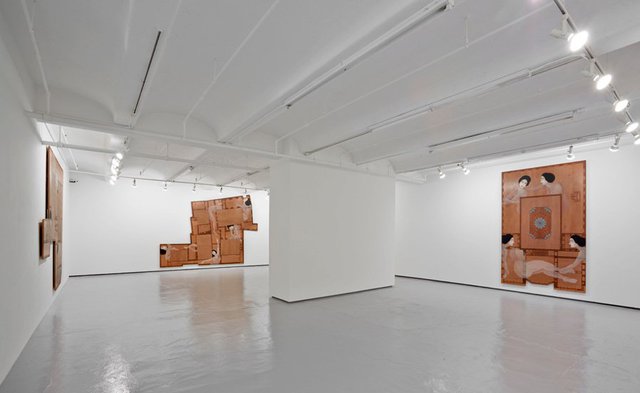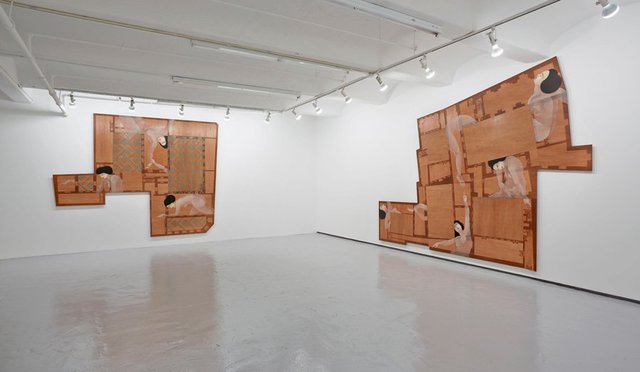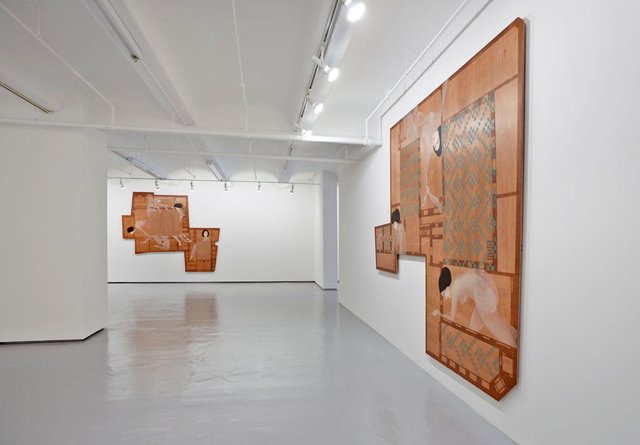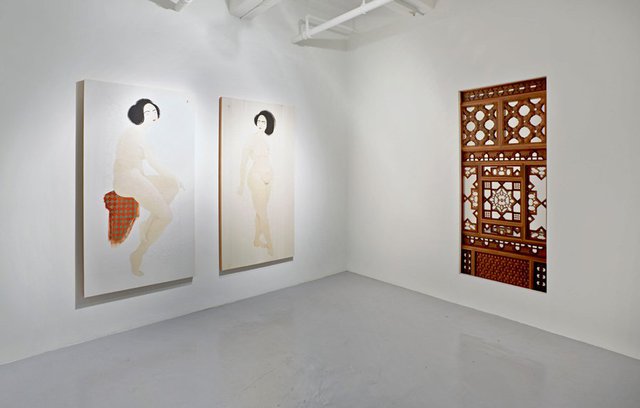Projects
SENSING OTHERWISE
A Story of an Exhibition
I.
You just arrived, half an hour late. Had to walk three blocks. There was an accident and a traffic jam. The taxi left you on 8th and 22nd. There is already a small crowd in the gallery. You pick up the description of the exhibit and the list of pieces being exhibited. You walk to the first large panel, in the wide entrant hall of Shainman Gallery. Now, you are looking at an oil painting on wood panel, Bab el Sheikh (2013).You look at the details; you step back and appreciate the modular construction of the surface: small panels, which you notice are mounted together, like in a puzzle. The panels are neither rectangular nor square.
You gaze at the floating female bodies – they look transparent. You fixate on their movements: those graceful arms and legs that blend with the colour of the wood. The women are not naked, nor do they have clothes.
'Interesting space disposition,' someone behind you says while looking at the same large panel.
'Yes,' you respond without looking back.
'The shape follows the contour of an aerial view of a house in Baghdad,' the person continues. He tells you he is an architect.
You walk together toward the main room of the gallery, where four other panels are hanging. You see a rectangular panel facing the entrance. But before you reach this rectangular panel, you spot a third panel to your right, hanging on the same wall: House in Kathemiya (2013).
You stop and step back to look at its shape. Similar contours than those in Bab el Sheikh. They all have similar shapes and perspectives: aerial views of a house with women floating within the frame like ghosts, rendered on surfaces that are somehow misshapen and modular.
'These houses with a courtyard have a long history, from Persia to the Arab world, and even to the South of Spain,' says your interlocutor. 'You can find them there still today: hundreds of houses of this type with a courtyard at the center. It is interesting to me how Hayv is blending architecture and history with feminism.'
There are one or two square distinctive spaces in each panel; a light green tone. 'That must be the courtyard,' you say to yourself. You are familiar with houses with courtyards, but had failed to realise that was not only the contour of an aerial view, but an aerial view in which the courtyard has been flattened.
'Yes, indeed,' you respond. 'The Silk Road, through oasis and deserts, from Baghdad to Samarkand: the same civilisational patterns. Do you know the artist?' you ask.
'She was born in Baghdad –'
'Oh. I know that.' You interrupted him. 'I also know that her family left the country when she was ten because Saddam Hussein was bombing the Kurdish region in the North of Iraq. The family settled in Sweden. I also know she studied graphic design in Florence and web design in Sweden.'
'So you know her.'
'No. I know of her but do not know her. How do you know her?' You want to know more.
'Just by chance – She was doing research in Baghdad in preparation for this exhibit. She was looking for house floor plans and she was working with architects who are friends of mine. I was in Baghdad at that time and meet Hayv.'
'Are you Iraqi too?' you ask.
'No. I am from London but live in New York. Twin cities – you know, like Minneapolis and Saint Paul.'
Funny, you think.
II.
You're in the middle of the room where the four panels are hanging. You look at them from a distance, and move to avoid the white column in the middle of the room, blocking your view. Then you approach each panel to see the details: the patterns, the invisible floor plan, the contours of the buildings viewed from above, the walls, the borders in the panel like dividing walls, the screen in the middle, over the courtyard.
'What do you know about the courtyard?' you ask your interlocutor.
'It is a very interesting space and very problematic at the same time,' he says.
'Why so?'
'It is deeply engrained in Muslim, Persian and Arab notions of experiential space.'
'And Samarkand,' you add.
'Yes, sorry. And Samarkand. It is like the front yard and the back yard in urban American architecture. Are you American?' he asks.
'My father is, I was born in Uzbekistan; my mother is an Uzbek Muslim. In Samarkand many houses with a courtyard remain, they are still standing. Samarkand was not bombed. We moved to US when I was 18.'
'So, you may know what I mean.'
'Yes, I do. And what I like is that the courtyard is the space that connects the outside, the street, with the inside, the house – a border space of sort. And as any border space, there is a hierarchy between the two sides of the border.'
'Certainly, the architecture of the courtyard is a problematic space because it is a spatial differentiation of gender roles. It is the place where men meet. Women are inside. But, women can observe men in the courtyard without being themselves observed. That doesn't ameliorate gender relations for women but it is part of the spatial distribution of gender roles.'
As he speaks, your eyes become glued to the magnificent oil on woodwork depicting a complex floor plan with five interior courtyards: Five court compound (2013). 'I guess you're right,' you respond half listening, half caught in the entanglement of walls, partitions and floating ghost-like women; you are mesmerised by that blending of flesh with the materiality of the building. 'Kahraman´s work demands an uncoupling of aesthetics from aesthesis,' you murmur.
'What do you mean?' – he nterjects your reverie.
'I mean, she is liberating her sensibility from the prison house of Western art history and sensibility. She has to go through the technical aspects of Western art, but that is all, she doesn't have to obey the expected regulations. And as a matter of fact, she doesn't.'
After a pause, you continue: 'You see, if you are from Iraq and move to Europe and the US, it is not the same as being from France and moving to the US or to Iraq. There is a differential in the value of human beings that today are measured by Consulates and by passports. An artist carrying a non-European passport and experiences and dwelling in Europe or the US embodies that difference and that difference is migrant consciousness.'
'That's an interesting idea,' he responds. 'It makes me think that consciousness is only a universal awareness while could only carry the singularity of local memories and sensibilities. Otherwise, it doesn't make sense to speak of consciousness without an adjective.'
'Yes, you are right.' You agree with enthusiasm. Kahraman's body has been stamped with body-political differentials. Her work is at once both a response to what migrants are made to feel and a denial to surrender towards that feeling. Migrant consciousness is either a curse or a blessing. In Hayv's work it is a blessing.'
He interrupts. 'That's why we have to uncouple aesthetics from aesthesis to understand Hayv's work. That makes sense. I remember a conversation in Iraq, a lunch we had with the architects Hayv was working with. She was telling us about her work. I remember Hayv saying that she threw herself fully into her art. I did not understand what she meant at that time. Now perhaps I am beginning to understand what she meant – she is there, in those women entangled within the walls: they are her. And she is there for a reason. Now I see; and the reason is that her work emanates from a dark, female complexity – from migrant consciousness and from her awareness of Iraq in the global order.'
'Yes, yes,' you react eagerly. 'Yes. That's why she's been questioning identity and identification, not only in how you identify yourself but how you identify yourself in relation to how you are identified when you are a migrant, and more so if your are from the Middle East.'
'How do you know that?' he asks.
'Oh, I don't know, I read it somewhere, or perhaps someone told me.'
III.
A brown-skinned and dark-haired woman, young and elegant, all dressed in white, is distributing large cards to viewers. She extends one to each of you.
You both walk back to the first panel, Bab el Sheikh. Standing there and looking back to the main room you exchange views on the exhibit, and read what is on the card:
The house is my domain. When you enter you will resign and obey. At least that's what I have to believe if I were to survive. Indeed you can have the rest but these rooms, these kitchens, these balconies, these toilettes are mine. They are an extension of myself. And within the confines of these walls I will do what I please. I will watch you from above. Through the screens I can see everything you do and you wont even know that I'm watching. I will laugh when you stumble and I will hear your conversations with others. You will not see me because you can't handle seeing me. I am too seductive. My black hair, my skin. I am behind these walls. Tamed and constrained. Yet this is my domain."
'That explains it,' your interlocutor says.
'Explains what?'
'Sandro Botticelli: Italian male. He painted red- and blond-haired and white-skinned women, naked. There was a sensibility that prompted his art, a renaissance sensibility imbibed with a regional sense of beauty and a system of gender.'
'I don't understand where you are going with this,' you interrupt, again.
'There is another sensibility in Hayv's work – a female that migrated from Iraq, and paints black-haired and brown-skinned women. You know, the Greek word aesthesis means sensing, sensations, what we feel in our bodies. European philosophers of the eighteenth century appropriated aesthesis and colonized it. They did it by regulating their own taste and disregarding the taste in other civilizations that were not their European taste.'
'I see,' you say, and indeed you begin to 'see' and understand what has been shaping your taste and sensibility without you knowing it.
'Aesthetics,' he continues, 'became a form of western policing through taste. Now we are here witnessing a re-emerging of what is alien to western sensibility but, yet, rendered in a visual frame that makes it some how familiar. It is border aesthesis, indeed – that is, a sensibility that is grounded in non-western memories rendered familiar by the appropriation of western visual codes.'
'It's like sensing otherwise,' you concede. You turn to face the entrance to a small room. Before entering, you see that there is still another small room in the back. 'Look,' your interlocutor says: 'a Mashrabiya.'
The rectangular Mashrabiya has been placed in the centre of the white wall that divides the two rooms in the gallery. You both enter the first room and approach the Mashrabiya. 'What is a Mashrabiya?' you ask.
'The Mashrabiya, like the courtyard, cuts deep into Islamic visual memories. It is a sort of screen of ornamental designs but very functional. It regulates air circulation and sunlight. But it is also a place to observe without being observed. You see, what we were talking before about the courtyard. Women behind the Mashrabiya look at men in the courtyard, a type of voyeurism that puts women in a temporary status of domination.'
You put everything together: the houses, the courtyards, naked ghost women, almost transparent bodies embedded in walls, screens regulating air and sunlight are at once offering a place of observation without you being observed. All of a sudden you fee; as if you are in a courtyard, being observed from the small room you cannot enter. The Mashrabiya is blocking the entrance.
IV.
'Look,' the architect says while taking a closer look at the human torsos shaping the figures of the Mashrabiya. 'See the torsos have the same shape as the women's bodies on the canvas and the woman in the painting, in this room and in the room we can not enter. We have to peek through the Mashrabiya. We are like the women in the house, looking through the Mashrabiya. We, the guest, are allowed to be the master. We are voyeurs!'
'You're right,' you say after a while. 'Now I just realise that all those women are one woman.'
'Sure,' your interlocutor says, as if he knows something you don't.
'What do you mean?' A strange sensation runs through your spine.
'I mean,' he says, 'that if she scanned her body as you said a few minutes ago, then she most likely scanned herself all around and used that scan on the canvas and in the painting.'
'And how do you know that?'
'This is something I remember from the conversation at lunch, in Baghdad about a year ago.'
'She scanned her body,' you repeat, as if asking yourself.
'Yes, what surprises you? We are all being scanned all the time,' the interlocutor continues. 'Every time we go through those scanning machines at security control, arms up, and nude to the voyeur who is policing us.'
The sensation in your spine increases. You have never thought about being seen nude each time you acquiesce to a scan at the airport: any and every airport.
You are silent for a few minutes, watching the torsos, peeking into the room you could not enter, watching the painting on the two walls of both rooms: the women, the woman. The nude bodies are disrupted when you approach the painting: geometric shapes and rounded or curved geometric figures replicate the scanned organs that compose the Mashrabiya.
You approach the paintings on the wall, one at the time: Tetrahedron (2013)on one wall and Octahedron (2013) on the other. You cannot see the title of the painting in the room you cannot enter, but you see that the paintings have the same logic: a naked woman's body. You feel like security. You are behind a screen, watching. You concentrate on the straight lines of flat platonic solids (those you liked so much in elementary school when learning geometry), and those rounded geometric figures disrupting it.
'This confounds me,' you interlocutor says, who is also looking at the painting with the kind of attention one might expect from an architect.
'I can imagine this is not architectural design,' you tell him.
'It certainly isn't.'
V.
You ramble, trying to organise at least some of the thoughts that come to your mind: 'The rounded figures remind me of Arab and perhaps Persian ornamental designs and architecture. There are no rectangles or straight lines, you see beyond the flat geometric figures. I have seen this in previous works by Kahraman. It sounds to me like she is disturbing geometric forms so dear to western civilization with geometric forms that are so dear to Islamic civilization. She uses those round forms like weapons.'
'But these particular round shaped geometric figures don't look to me like Islamic shapes.'
You think for a while. Something is dancing in your head, like a déjà vu you can't place. You think about the composition of the painting: naked body, flattened platonic solids disrupted by round shaped forms, as if those forms where coming not from geometry but from the inside of the human body. Then, bingo, – you remember Extimacy (2012), one of Kahraman's previous exhibitions that most impressed you; like an even earlier show, Sacrifice (2008)..[1]
'You seem to have discovered something,' your interlocutor observes.
'Well – not discovered but remembered. In Extimacy, Hayv scanned her body and 'externalised' the organs. It is a powerful de-eroticisation of the female body that we find particularly in the western world and its areas of influence. Her work, I am realising, is deeply sociogenetic.'
'Sociogenetic?' the interlocutor asks. He's never heard of the word.
'I mean, it is how you conceive your own identity once you realize that your identity depends on your awareness of how you are perceived by others. And if you are a brown skinned and dark haired women in the West, well, you become aware of that pretty soon.'
While you are talking, two men in suits and ties and the woman you had seen welcoming visitors at the entrance of the gallery enter the room you do not have access to, blocked by the Mashrabiya. You notice a door there. 'Who are they?' you ask your interlocutor.
'I don't know.'
'And why they are entering there and we cannot?'
'I don't know. But I do know that the most private room in a house is at the back of it. This seems to be that kind of room.'
At that moment you feel someone touching your arm, calling your attention. You turn and next to you is the same brown-skinned, dark-haired woman dressed in white that handed to you the first card a short while ago. She extends another large card to you, which you receive. It says:
I'm a commodity. My paintings are a commodity. My figures are a commodity. I pose in the nude and photograph my body to use as outlines for paintings. My figures then are visual transitions of my own body. They are buying my body. The figures are rendered to fit the occidental pleasures. White flesh. Transparent flesh. Posing in compositions directly taken from the renaissance. Conforming to what they think is ideal. Neglecting everything else. Colonizing my own body to then be displayed gracefully into my rectangular panels. Carnal and visceral palpability. I provide for you in my rectangles. I know you like it. That's why I paint it. To catch your gaze. To activate your gaze. I want you to buy me so you can look at me all day long. I'm your little oriental pussycat. You can pet me I don't bite.
You finish reading and check the time. It's late. Your friends will be at Pegu in ten minutes. You walk to the door and turn around to say goodbye to your interlocutor, but he's not in the room. You look for him in the gallery where the four large panels are. He's not there either. You walk towards the exit and look back once again. You do not see him.
You exit, call a taxi and feel the sensation of a shift. Botticelli – with his naked, white-skinned and fair-haired women – has been reduced to size.
[1] Eid Al Adha (Feast of Sacrifice) commemorates Ibraham's (Abraham) willingness to obey God by sacrificing his son. Kahraman series depicts elegant women decapitating a lamb, taking away the job traditionally done by men, and not necessarily in elegant attires.









